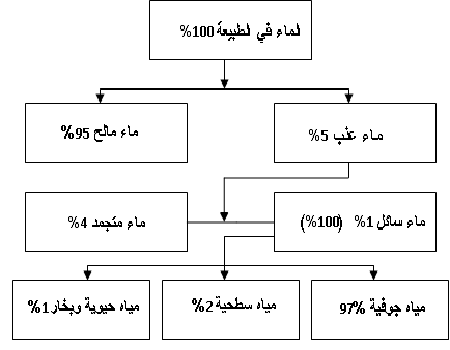| News Details |
Irrigation water in nature and its sources
2022-04-16

Dr. Saleh Mahmoud Saleh
The Upper Euphrates Basin Development Center / University of Anbar
The importance of water:
Water is one of the most important natural resources as it is the main pillar of all biological, social and economic activities of man. As Almighty Allah said: “and made from water every living thing” (Al-Anbiya’a: 30), Nevertheless, water is not given the same importance and care as many other resources, particularly oil. The wise described the water as the cheapest and most precious missing. The issue of water security has become a life and economic necessity directly related to the future of countries, and water security has been seen as the main objective of each country's water policy to achieve its food security. Water accounts for 71 percent of the total surface area of the earth, and land accounts for 29 percent of it. The problem of water today and in the future is the growing demand for water resources increasingly on the one hand and the limited supply of those resources on the other hand, so the goal of the Arab world, including Iraq, is to balance the available water resources with the growing demand for water, so efforts must be made to develop water resources in order to meet the various domestic and industrial needs. The problem of water losses in irrigated agriculture is one of the most important problems in the agricultural uses of water resources, as the mismanagement of the irrigated agriculture system, particularly with regard to irrigation water, has contributed effectively to the increase of water losses and the degradation of soil fertility and its physical and chemical properties, in addition to the emergence of the problem of drainage. Iraq is located according to "environmental division within the desert region with a dry and desert climate that enjoys a small percentage of rainwater with a variation in its water supply from year to year, resulting in a decrease in average per capita water resources, and any country is classified as one of the countries facing a severe water crisis, with the average per capita water available below 1,000 m3 per year." The water problem is exacerbated as the population continues to grow year after year, as the demand for water for all uses increases without a substantial increase in available resources.
Irrigation: An agricultural process to provide the plant with the water it needs, irrigation alone is not enough for crop and plant growth, but is useful and effective in its interaction with other agricultural processes, such as soil preparation, fertilizer addition, grass and rodent control, good harvesting, and appropriate suitable drainage.
Irrigation purposes: To ensure the crop against short-term droughts, to reduce soil temperature and the surrounding atmosphere to create environmental conditions suitable for plant growth, to reduce the impact of frost on the plant, as well as to wash the soil from salts, reduce soil cracking and facilitate the fragmentation and dismantling of coherent soil cracks during tillage.
The importance of irrigation is not only in dry areas, but also in other areas for its many benefits. Irrigation is the best guarantee of successful agriculture and development in areas with frequent fluctuating rains during the seasons, or if rain is delayed or reduced.
Climate zones:
The world has been divided into four major climate zones according to the annual rainfall rates as shown in Table 1.
Table 1: Classification of climate zones in the world
|
Climate zones (mm) wet areas semi |
annual rainfall (mm) |
|
humid areas |
more than 1000 |
|
Semi humid areas |
500 – 1000 |
|
Semi-arid areas |
250-500 |
|
Arid areas |
Less than 250 |
The importance of irrigation in different agricultural areas:
Agriculture can be divided into three main types in terms of water supply to crops:
1- Rain agriculture: In wetlands, agriculture relies entirely on rainfall, which is usually sufficient to produce most types of agricultural crops.
2- Dry agriculture: In the world's semi-humid and semi-arid regions, the plant receives part of its water requirements through rain that may be sufficient to produce some crops.
3- Tropical agriculture: In this way, the plant has all its water requirements for its growth through irrigation. Tropical agriculture is generally concentrated in desert and semi-desert areas, which account for almost one third of the world's land area.
The amount of annual rainfall falls is not a sufficient criterion for judging the need for irrigation or the way land is used, but there are other factors that may affect this, such as: the effectiveness and impact of rainfall, seasonal distribution of rain and the amount of evaporation of water bodies and agricultural land. The amount of evaporation depends on temperature, air humidity, wind speed and other atmospheric factors.
If evaporation rates exceed normal rainfall rates in any climatic zone, the area is considered dry, and under these conditions there can be no successful cultivation without the addition of water to soil and plant by industrial means.
Irrigation water sources: Rain and snow are the main source of water in nature, with a section of rain flowing above ground, forming surface water (rivers and lakes), or part of it running deep into the soil and feeding groundwater. The process of rain and snow being distributed to the globe is called the hydrological cycle or the water cycle in nature (Figure 1).

Figure 1: A diagram for water cycle in the nature
Most of the water available in nature is salty, and fresh water is low (Figure 2), and in general the water sources in nature have been divided into traditional and non-traditional water.
1- Traditional water sources: rain, surface water (fresh lakes, rivers, springs) and groundwater.
2- Non-traditional water sources: Other sources that constitute recent secondary sources of irrigation water and vary in their contribution rates and how they are exploited for irrigation include: processed drainage waste water, saline desalination and rain simulators.
Basic procedures:

Figure (2): Illustration for the diverse water ratios in nature
Water Resources Conservation:
The official water management authorities in most countries of the world are developing their plans and perceptions for the conservation of water sources based on the following methods:
1- Work to rationalize the use of irrigation water in agriculture by improving the efficiency of existing irrigation systems.
2- Reducing water loss as a result of water leakage from irrigation watercourses.
3- Develop irrigation methods and use modern irrigation methods in new projects.
4- Establish projects to reserve rainwater, floods and floods.
5- Exploitation of groundwater within appropriate limits and not being unfairly drained.
6- Reuse of agricultural and waste water for agricultural purposes.
7- Desalination of saltwater by economic means appropriate to the nature of the region.









